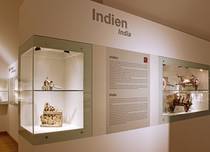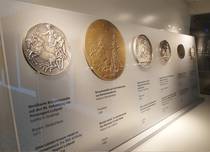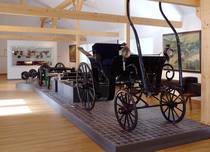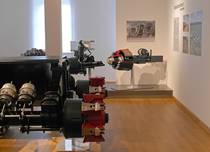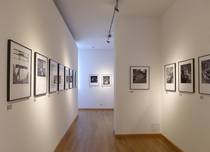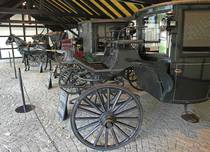Exhibition
Besides the historic and modern axles by BPW, the collection presents prehistoric and antique exhibits from Europe, Asia and Africa, as well as modern exhibits on the topic of vehicle construction. The cultural history of axle, wheel and carriage is depicted on an area of 2,000 sqm, with 1,000 sqm exhibition space.
In addition to the museum pieces, there are also interactive stations, such as a digital map of the world, which has the topic of the creation and distribution of the carriage. Many hands-on models enable the visitor to get to grips with the topics brake, bearing, steering and suspension. In doing so, the technical particularities and the historical development of components are demonstrated.
The items of the collection are exhibited in three large rooms. The visitor is led through the exhibition chronologically. The first room starts with the topics Ancient Near East, Central Europe and moves from the ancient world and India to China. At the end of the first room, coins, graphics and teaching models of modern time’s running gear technology create the transfer into modernity in the second room. Here, vehicle construction and the associated trades are presented.
Furthermore, the second room presents the early company history of the Bergische Achsenfabrik up to 1948, with the development from the simple iron axle for carriages, to high-quality patent axles for coaches, to the roller bearing axle, which revolutionised vehicle construction in the 1920s.
The following third room presents the history of BPW and its products from 1948 onwards. The development can be followed through the milestones such as introduction of the square tube hollow axle, the air spring and the disc brake. Steering and driving axles are taken into account in the same way as are the particularly impressive special axles, which are designed for highest loads and robustness.
But there is not only steel on display: A photo gallery with works of the industry photographer Ruth Hallensleben reflects work life at BPW in the 1950s. If you follow the picture presentation clockwise, you will gain an insight into the production process from delivery of the raw material to the forging and fitting processes right up to the ready-to-ship axle. The worker is always in the foreground.
In the outside area, a smithy and coach houses are grouped around the yard. The coach houses are home to special and in parts very rare coaches of the 19th and early 20th centuries, and commercial vehicles of the 20th century, ranging from the sack barrow to the lorry trailer dating 1925.
